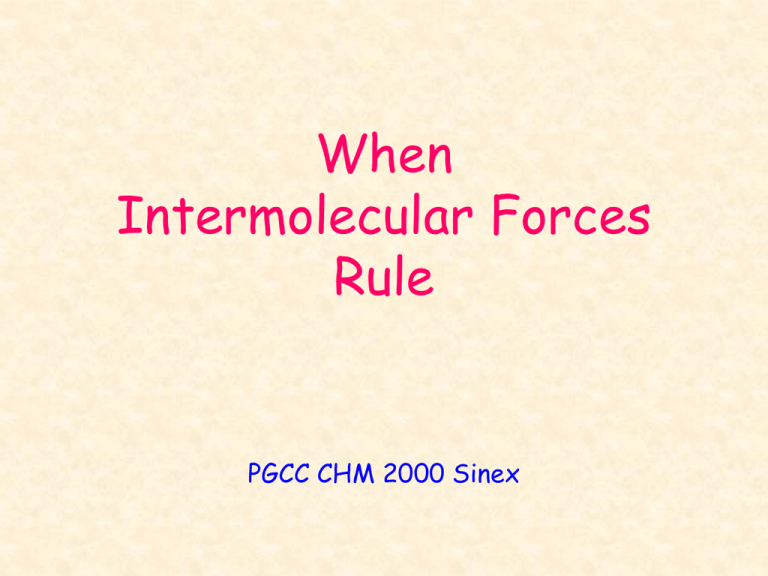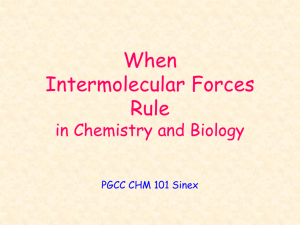When Intermolecular Forces Rule PGCC CHM 2000 Sinex
advertisement

When Intermolecular Forces Rule PGCC CHM 2000 Sinex Comparison of properties for the states of matter Property Solid Liquid Gas Volume Shape definite definite definite indefinite indefinite indefinite Relative density Compressibility high low-none ~1 g/mL low-none very low very high Fluidity/mobility Particle packing Diffusion rate Motion of particles no close very slow vibrations only Forces between particles IMF’s or bonding yes yes close far apart medium fast translation translation rotation rotation IMF’s only none if ideal gas The liquid state of matter Molecules are closely packed but free to move about randomly. There must be a force of attraction between the molecules. As molecules start to vaporize Molecules are great distances apart in gaseous state but free to move about randomly. What about in solids? Click here for a simulation of the states of matter Force-distance relationship For the Fattraction proportional to 1/distance molecules in contact with each other Relative attractive force 1 0.8 0.6 0.4 0.2 0 0 1 2 3 4 5 6 7 8 Relative molecular distance 9 10 Force-distance relationship Relative attractive force 1 1 0.8 0.6 0.4 0.2 0 0 1 2 3 4 5 6 7 8 Relative molecular distance 9 10 Force-distance relationship Relative attractive force 1 2 0.8 0.6 0.4 0.2 0 0 1 2 3 4 5 6 7 8 Relative molecular distance 9 10 Force-distance relationship Relative attractive force 1 3 0.8 0.6 0.4 0.2 0 0 1 2 3 4 5 6 7 8 Relative molecular distance 9 10 Force-distance relationship Relative attractive force 1 4 0.8 0.6 0.4 0.2 0 0 1 2 3 4 5 6 7 8 Relative molecular distance 9 10 Force-distance relationship Relative attractive force 1 5 0.8 0.6 Less than 20% the strength at 5 molecular distances 0.4 0.2 0 0 1 2 3 4 5 6 7 8 Relative molecular distance 9 10 Increasing strengths of IMF The strength of IMF’s • • • • • • • H-bonding (fixed distance ~200 pm) Ion-ion (1/r) Ion-dipole (1/r2) Inverse 3 Dipole-dipole (1/r ) functions of Ion-induced dipole (1/r4) distance 6 Dipole-induced dipole (1/r ) to various powers Induced dipole-induced dipole (1/r6) How do the other functions behave compared to 1/r? Click here for an interactive Excel spreadsheet to explore Hydrogen bonding in water O-H 96 pm covalent bond … H 186 pm O Base Pairs in DNA: H-bonding AT pair Why not here? GC pair What holds the iodine molecules together in solid iodine? 272 pm for I2 covalent bond 427 pm between two molecules in crystalline structure About half an iodine atom space between molecules Graphite weak intermolecular forces between layers (van der Waals forces) graphene C-C bond distance: 142 pm C to C distance between layers – 336 pm



